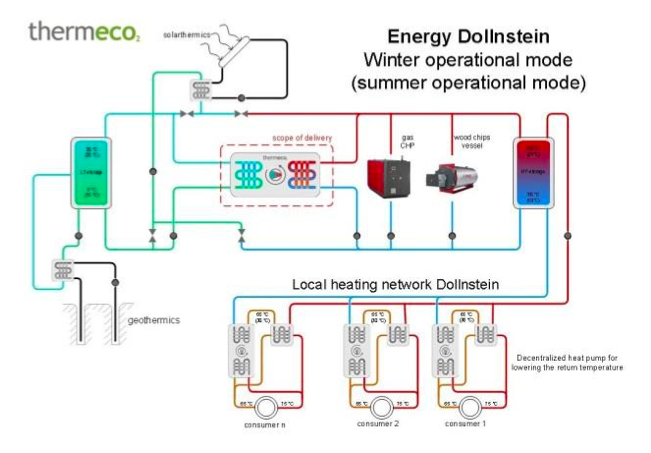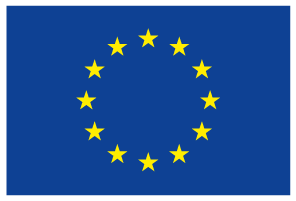Germany
2014
- Type : Project
- Size : Local community
- Area : Residential
Environmental benefit
Low Temperature Heating Grid in Dollnstein
Share
Germany
2014
- Type : Project
- Size : Local community
- Area : Residential
Environmental benefit
Discover this use case online

The concept of the Dollnstein local heating network is primarily based on two parts: utilisation of renewable energies and flexible temperatures adjusted to the consumption. In a typical network the heating utility permanently provides hot water of 80 °C. In summer, there is no appropriate demand for such a temperature in a small town like Dollnstein, which causes high heat losses. Therefore, the network temperature from May till October is lowered to 20-30 °C. This allows covering the heat demand in summer operation completely by renewable energy, as described below.
In winter half of the energy comes groundwater, which is available at shallow depths. In the heating centre the thermeco2 high- temperature heat pump with a capacity of 440 kW is located. It extracts thermal energy from the low temperature storage tank (which uses the groundwater and the solar panels as energy source) and, thus, provides flow temperatures up to 80°C in the winter heating period. The feature of this technology: the system works with the environmentally friendly refrigerant CO2.
In the summer months, there is enough solar energy to keep the network temperature at 20 °C to 25 °C. For the hot water demand of private households, for example for showering, this is, however, not sufficient. That is why the transfer stations in the houses are equipped with a small heat pump and buffer storage each. A combined heat and power plant (CHP) and photovoltaic power plants supply the electricity for the thermeco2 machine and the pumps in the households.
In an intelligent system, the heating centre, heating network and consumer are connected to each other – including power supply of the consumer stations. A control cable forwards information about temperature of buffer storages, consumption and other data to the heating center. By doing so, the buffer storages in the houses can be charged in line with the demand. Thus, the small heat pumps only run, if hot water is demanded. To take full advantage of the waste heat from the CHP and of the existing solar plants there is high- temperature buffer storage of 27 m3 and a slightly smaller low-temperature storage.
 R-ACES has received funding from the European Union’s Horizon 2020 research and innovation programme under grant agreement N° 892429
R-ACES has received funding from the European Union’s Horizon 2020 research and innovation programme under grant agreement N° 892429
The concept of the Dollnstein local heating network is primarily based on two parts: utilisation of renewable energies and flexible temperatures adjusted to the consumption. In a typical network the heating utility permanently provides hot water of 80 °C. In summer, there is no appropriate demand for such a temperature in a small town like Dollnstein, which causes high heat losses. Therefore, the network temperature from May till October is lowered to 20-30 °C. This allows covering the heat demand in summer operation completely by renewable energy, as described below.
In winter half of the energy comes groundwater, which is available at shallow depths. In the heating centre the thermeco2 high- temperature heat pump with a capacity of 440 kW is located. It extracts thermal energy from the low temperature storage tank (which uses the groundwater and the solar panels as energy source) and, thus, provides flow temperatures up to 80°C in the winter heating period. The feature of this technology: the system works with the environmentally friendly refrigerant CO2.
In the summer months, there is enough solar energy to keep the network temperature at 20 °C to 25 °C. For the hot water demand of private households, for example for showering, this is, however, not sufficient. That is why the transfer stations in the houses are equipped with a small heat pump and buffer storage each. A combined heat and power plant (CHP) and photovoltaic power plants supply the electricity for the thermeco2 machine and the pumps in the households.
In an intelligent system, the heating centre, heating network and consumer are connected to each other – including power supply of the consumer stations. A control cable forwards information about temperature of buffer storages, consumption and other data to the heating center. By doing so, the buffer storages in the houses can be charged in line with the demand. Thus, the small heat pumps only run, if hot water is demanded. To take full advantage of the waste heat from the CHP and of the existing solar plants there is high- temperature buffer storage of 27 m3 and a slightly smaller low-temperature storage.
